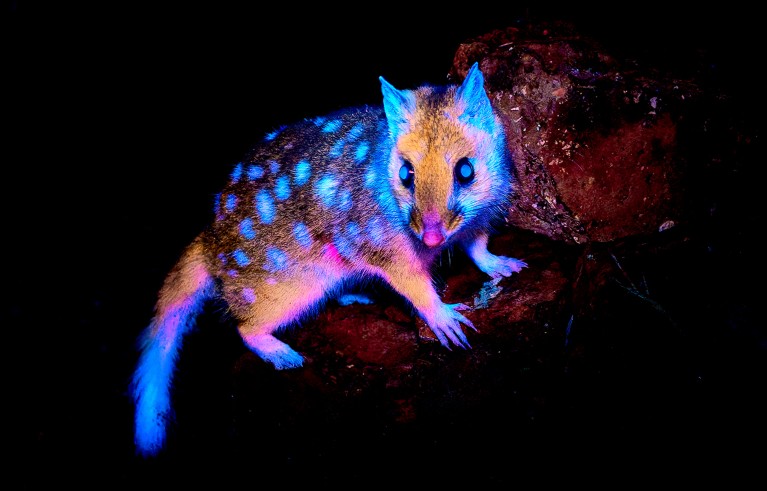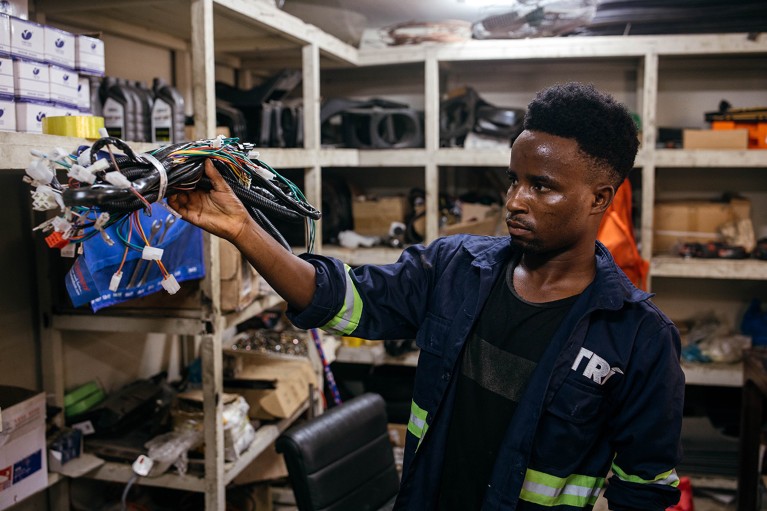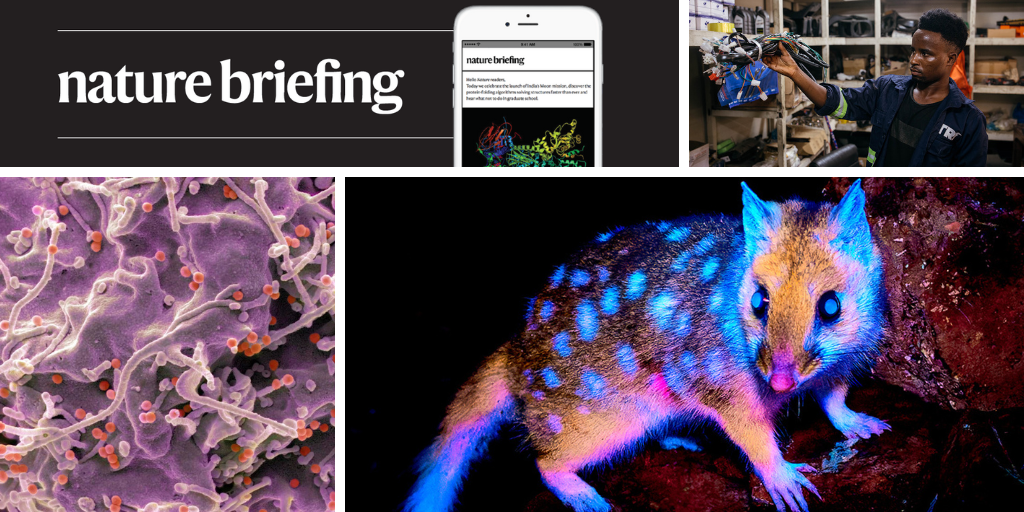You have full access to this article via your institution.
Hello Nature readers, would you like to get this Briefing in your inbox free every day? Sign up here.

Credit: Ben Alldridge
This snap of an eastern quoll (Dasyurus viverrinus) is the first to show a wild marsupial glowing under ultraviolet (UV) light. Under visible light, this animal’s fur appears brown or black with white spots. When ultraviolet light shines on the animal, patches of its fur can absorb and re-emit it at a different wavelength, creating the vibrant blue glow you can see here. The picture earned photographer Ben Alldridge a spot as a finalist in the Beaker Street Science Photography Prize 2025.
See more of the month’s sharpest science shots, selected by Nature’s photo team.
Two vaccine candidates that use mRNA technology elicit a potent immune response against HIV. These vaccines use mRNA to instruct a cell to make proteins called envelope proteins that are attached to the cell membrane — similar to how they are found in live HIV. In a small trial, some 80% of the participants who received three doses of either of the vaccines went on to produce antibodies that could block that protein from entering cells.
Reference: Science Translational Medicine paper
India’s national university ranking will start penalizing institutions if their researchers rack up too many retractions — a first for an institutional ranking system. Around 2 in every 1,000 papers published in India are retracted, often because of misconduct or research-integrity concerns. Some researchers have welcomed the decision as a first step to tackling the problem, but others argue it doesn’t remove other incentives such as promotions that encourage quantity over quality in publishing papers.
Eating ultra-processed foods (UPFs) — products that combine food extracts with additives and industrial ingredients — might hinder attempts to lose weight even when the diet accords with national healthy-eating recommendations. In a trial, participants’ weight and body-mass index decreased during both a 4-week diet based on minimally processed foods (MPFs), and one following a diet based on UPFs. But participants lost more than twice as much weight on average when following the MPF diet, and changes in body composition, such as decreases in fat mass, were smaller on the UPF diet.
Reference: Nature Medicine paper
Features & opinion
In April, biotech firm Colossal Biosciences made a bold announcement: “The first de-extinct animals are here.” The company’s release, which described three gene-edited pups they call dire wolves (Aenocyon dirus), set the stage for an ongoing scientific clash. In one corner, some researchers said the company’s announcement had overhyped the research, and might confuse the public. In the other, scientists from Colossal stood by their work, using an increasingly combative tone. Colossal’s response to criticism has some concerned about how the company will conduct itself as it moves ahead with plans for more ‘de-extinctions’.
Since 2013, sea star wasting disease has killed more than one billion starfish along the west coast of North America. Algal blooms, oxygen loss and an unidentified virus were all suspects over the years, but now researchers think they’ve found the culprit: Vibrio pectenicida, a bacterium that worms its way into a starfish’s internal fluids. One mystery solved; the next to tackle is what scientists can do about it. Vibrio species are widespread in ocean environments, and warming waters could help bacteria to spread faster than scientists can put safeguards in place.
Reference: Nature Ecology & Evolution paper
In Captured Futures, political scientist Maarten Hajer and social scientist Jeroen Oomen argue that environmental politics in its current form — one that hinges on technocratic solutions and policy processes — is doomed to fail. What could work instead, they argue, is more aspirational storytelling that evokes a sense of renewal, rather than fear. Captured Futures is “arguably the most important book on environmental politics in the past decade”, writes social scientist Philip Macnaghten in his review. “We should not give up hope; we must unleash the power of liberating stories.”
Where I work

Erasto Job is a technician at TRí in Dar es Salaam, Tanzania.Credit: Kang-Chun Cheng for Nature
Erasto Job is a technician at TRí, a company that makes electric versions of three-wheeled vehicles. Many people in Tanzania rely on such vehicles because they are among the cheapest and safest modes of transportation there, he says. He assembles the vehicles and fixes any mechanical or electrical issues that arise in TRí’s products. “I love this part of my job: tracing where the problem is coming from, figuring out how to fix it then making sure the fix works.” (Nature | 3 min read)
On Thursday, Leif Penguinson was taking a dive at a waterfall in Lushan Geopark in Jiujiang, China. Did you find the penguin? When you’re ready, here’s the answer.
This newsletter is always evolving — tell us what you think! Please send your feedback to [email protected].
Thanks for reading,
Jacob Smith, associate editor, Nature Briefing
• Nature Briefing: Careers — insights, advice and award-winning journalism to help you optimize your working life
• Nature Briefing: Microbiology — the most abundant living entities on our planet — microorganisms — and the role they play in health, the environment and food systems
• Nature Briefing: Anthropocene — climate change, biodiversity, sustainability and geoengineering
• Nature Briefing: AI & Robotics — 100% written by humans, of course
• Nature Briefing: Cancer — a weekly newsletter written with cancer researchers in mind
• Nature Briefing: Translational Research — covers biotechnology, drug discovery and pharma


